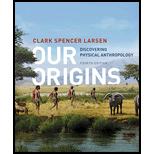
Concept explainers
Introduction: The humans are classified into three types based on the transition of external features and adaptability to the environment. They are Homo. Erectus, archaic Homo sapiens and modern Homo sapiens.
Explanation of Solution
Correct answer: Option d. Reduction in skeletal robusticity.
Reasons for the correct answer:
The archaic Homo sapiens is the first of human species that evolve locally from early Homo erectus population. They consist of mixture of Homo erectus and Homo sapiens characteristics. The reduction in the robusticity of skull and skeleton differentiates the archaic Homo sapiens from Homo erectus.
Option d. is given as “reduction in skeletal robusticity”.
Hence option d is correct.
Reasons for the incorrect answers:
Option a. is given as “presence in Asia and Europe”. The archaic Homo sapiens and Homo erectus distributed over Asia, Africa, and Europe. Hence, option a is incorrect.
Option b. is given as “loss of large browridges”. The loss of large browridges occurs in the modern Homo sapiens. Hence, option b is incorrect.
Option c. is given as “development of a projecting chin”. The development of projecting chin occurs in modern Homo sapiens. Hence, option c is incorrect.
Therefore, options a), b), and c) are incorrect.
Thus the reduction in skeletal robusticity distinguishes early archaic Homo sapiens from Homo erectus.
Want to see more full solutions like this?
Chapter 12 Solutions
Our Origins: Discovering Physical Anthropology (Fourth Edition)
- In a small summary write down:arrow_forwardNot part of a graded assignment, from a past midtermarrow_forwardNoggin mutation: The mouse, one of the phenotypic consequences of Noggin mutationis mispatterning of the spinal cord, in the posterior region of the mouse embryo, suchthat in the hindlimb region the more ventral fates are lost, and the dorsal Pax3 domain isexpanded. (this experiment is not in the lectures).a. Hypothesis for why: What would be your hypothesis for why the ventral fatesare lost and dorsal fates expanded? Include in your answer the words notochord,BMP, SHH and either (or both of) surface ectoderm or lateral plate mesodermarrow_forward

 Human Biology (MindTap Course List)BiologyISBN:9781305112100Author:Cecie Starr, Beverly McMillanPublisher:Cengage Learning
Human Biology (MindTap Course List)BiologyISBN:9781305112100Author:Cecie Starr, Beverly McMillanPublisher:Cengage Learning Concepts of BiologyBiologyISBN:9781938168116Author:Samantha Fowler, Rebecca Roush, James WisePublisher:OpenStax College
Concepts of BiologyBiologyISBN:9781938168116Author:Samantha Fowler, Rebecca Roush, James WisePublisher:OpenStax College Biology: The Dynamic Science (MindTap Course List)BiologyISBN:9781305389892Author:Peter J. Russell, Paul E. Hertz, Beverly McMillanPublisher:Cengage Learning
Biology: The Dynamic Science (MindTap Course List)BiologyISBN:9781305389892Author:Peter J. Russell, Paul E. Hertz, Beverly McMillanPublisher:Cengage Learning Biology (MindTap Course List)BiologyISBN:9781337392938Author:Eldra Solomon, Charles Martin, Diana W. Martin, Linda R. BergPublisher:Cengage Learning
Biology (MindTap Course List)BiologyISBN:9781337392938Author:Eldra Solomon, Charles Martin, Diana W. Martin, Linda R. BergPublisher:Cengage Learning Biology: The Unity and Diversity of Life (MindTap...BiologyISBN:9781337408332Author:Cecie Starr, Ralph Taggart, Christine Evers, Lisa StarrPublisher:Cengage Learning
Biology: The Unity and Diversity of Life (MindTap...BiologyISBN:9781337408332Author:Cecie Starr, Ralph Taggart, Christine Evers, Lisa StarrPublisher:Cengage Learning





